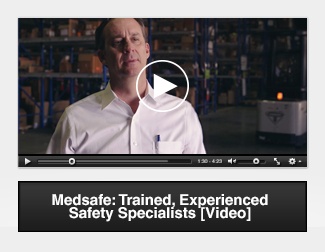
Choosing the right fall protection equipment... it can mean the difference between life and death. In fact, most workplace injuries associated with falls have an interesting cause. They aren’t a result of people not wearing the equipment. Rather, it's because they weren’t wearing it properly.
Today, we’re going to talk about two different types of fall protection lanyards. Keep reading to learn more about positioning lanyards and energy absorbing lanyards.
Positioning Lanyards
A positioning lanyard is part of a positioning device system. This type of system supports the employee on an elevated vertical surface, such as a wall or pole. This allows them to work hands-free while leaning. The lanyard connects the employee to an anchor point in front of their body.
The positioning system consists of a belt or body harness, the lanyard, and an anchor point. Body belts are only permitted to worn for positioning systems. They're also only suitable when the system permits a fall of 2 feet or less. Positioning equipment must meet specified requirements, set forth by both OSHA and ANSI.
When to Use a Positioning Lanyard
Employees who need the flexibility of using both hands often use positioning lanyards. Some examples include:
- Construction workers
- Linemen workers
- Window washers
It’s important to keep in mind that a positioning system is not considered a fall protection system. Positioning allows the worker more freedom to move around and work hands-free.
In most situations, a personal fall arrest system supplements a positioning system. In this case, workers must also use an energy absorbing lanyard (or a retractable lanyard if conditions permit). The positioning system and fall arrest system are separate from each other. They're not interchangeable.
If an employee is using a positioning device with a personal fall arrest system, they should be using a harness that provides attachment points for both a positioning device AND a fall protection system. Check the style of your harnesses to make sure they are compatible with both systems.
Relevant OSHA Standards
Take a closer look at the information listed below. These are some common standards for positioning, applicable to the construction industry.
1926.502(e) Positioning device systems. Positioning device systems and their use shall conform to the following provisions:
- 502(e)(1) Positioning devices shall be rigged such that an employee cannot free fall more than 2 feet (.9 m).
- 502(e)(2) Positioning devices shall be secured to an anchorage capable of supporting at least twice the potential impact load of an employee's fall or 3,000 pounds (13.3 kN), whichever is greater.
- 502(e)(5) Connecting assemblies shall have a minimum tensile strength of 5,000 pounds (22.2 kN)
- 502(e)(9) Positioning device systems shall be inspected prior to each use for wear, damage, and other deterioration, and defective components shall be removed from service.
- 502(e)(10) Body belts, harnesses, and components shall be used only for employee protection (as part of a personal fall arrest system or positioning device system) and not to hoist materials.
For a full list of OSHA’s positioning standards, visit their website here.
Energy Absorbing Lanyards
Energy absorbing lanyards, also known as shock absorbing lanyards, dissipate energy. They limit the deceleration forces an employee experiences during a fall. The energy absorbing lanyard, or EAL, is one part of a personal fall arrest system.
The components of a fall arrest system include:
- Anchorage Device (connected to a suitable Anchor Point)
- Body Harness
- Connecting Devices
- Deceleration Device
An easy way to remember this is to think of the ABCD’s - anchor, body harness, connectors, and decelerator. Each component has specific criteria that they must meet to follow OSHA’s standards.
When to Use an Energy Absorbing Lanyard
Energy absorbing lanyards are one of the most popular forms of decelerating devices. And workers are to always use a decelerating device when wearing fall protection. This includes circumstances such as:
- General industry
- When employees are working at unprotected heights of 4 feet or higher
- Construction
- When employees are working at unprotected heights of 6 feet or higher
- Mining
- When employees are working at unprotected heights where there is danger of falling
- Any use of personal fall arrest equipment
EALs will help you meet requirements when working in these situations.
Your other option for a deceleration device is a Self Retracting Lanyard, or SRL. These serve the same purpose as an energy absorbing lanyard in that they reduce the amount of stress placed on the employee during a fall.

Relevant OSHA Standards
The standards listed below are OSHA’s fall protection standards for general industry.
- 140(c)(4) Lanyards and vertical lifelines must have a minimum breaking strength of 5,000 pounds.
- 140(c)(5) Self-retracting lifelines and lanyards that automatically limit free fall distance to 2 feet (0.61 m) or less must have components capable of sustaining a minimum tensile load of 3,000 pounds (13.3 kN) applied to the device with the lifeline or lanyard in the fully extended position.
- 140(c)(18) Personal fall protection systems must be inspected before initial use during each workshift for mildew, wear, damage, and other deterioration, and defective components must be removed from service.
- 140(c)(20) Ropes, belts, lanyards, lifelines, and harnesses used for personal fall protection must be protected from being cut, abraded, melted, or otherwise damaged.
For a complete list of OSHA fall protection standards, visit their website here.
Knowing the Difference
Falls are the leading cause of death in the construction industry. According to OSHA, in 2015, there were 350 fatal falls in construction alone. And they continue to be a problem in most other industries as well.
The sad truth is, that most of these falls could have been easily prevented. How can employees protect themselves from the risk of a fall? They need the right training and the right equipment.
Most of the employees who died in 2015 were actually wearing fall protection. But they were wearing it improperly. How a person uses their fall protection equipment makes a difference - it determines how effective the equipment will be in saving their lives.
More on Fall Protection Equipment
At Medsafe, we understand how tough it can be to stay on top of the OSHA standards and requirements. There’s so much information out there that it can get overwhelming at times.
We’re here to help see you through it.
Visit our comprehensive FAQ page to learn more about fall protection systems and both positioning and energy absorbing lanyards.








